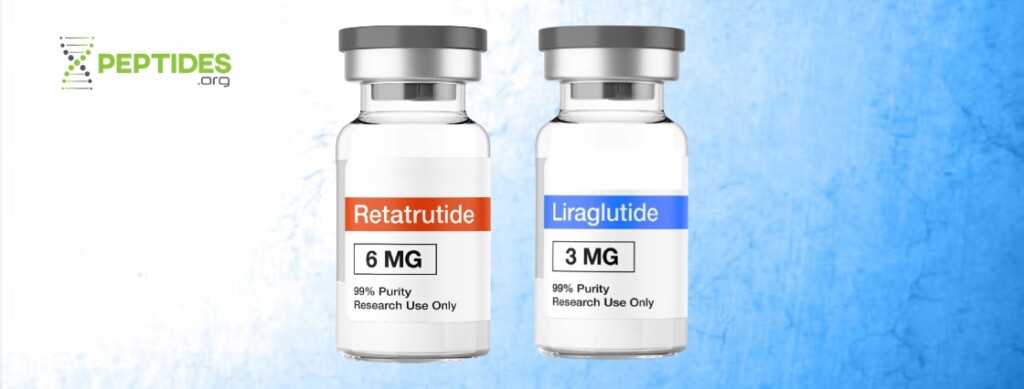Researchers looking for an expert comparison of retatrutide vs. liraglutide for weight loss may find this informative guide highly valuable for their future studies.
Retatrutide and liraglutide are two weight loss peptides that are studied for uses such as:
- Type 2 diabetes management
- Chronic weight management
- Cardiovascular risk reduction
While the two peptides have some similarities, they also possess distinct characteristics. Retatrutide is a novel triple-hormone-receptor agonist that is being investigated as a potential medication for weight loss.
On the other hand, liraglutide was among the first incretin mimetic peptides to receive approval for managing type 2 diabetes. It is also approved for reducing cardiovascular risks in diabetic patients and for weight management in both adolescents and adults.
This guide offers a detailed comparison between retatrutide and liraglutide, assisting researchers in deciding which peptide to prioritize for further study.
Additionally, our team will recommend reliable sources for purchasing research-grade liraglutide and retatrutide online at competitive prices.
Buy research peptides from a top-rated vendor today...

Disclaimer: Peptides.org contains information about products that are intended for laboratory and research use only, unless otherwise explicitly stated. This information, including any referenced scientific or clinical research, is made available for educational purposes only. Likewise, any published information relative to the dosing and administration of reference materials is made available strictly for reference and shall not be construed to encourage the self-administration or any human use of said reference materials. Peptides.org makes every effort to ensure that any information it shares complies with national and international standards for clinical trial information and is committed to the timely disclosure of the design and results of all interventional clinical studies for innovative treatments publicly available or that may be made available. However, research is not considered conclusive. Peptides.org makes no claims that any products referenced can cure, treat or prevent any conditions, including any conditions referenced on its website or in print materials.
What is Liraglutide?
Liraglutide is a glucagon-like peptide-1 receptor agonist (GLP-1 RA) developed by Novo Nordisk in the 1990s [1].
It was intended to improve glycemic control in type 2 diabetes (T2D) but was later found to be effective for other uses like weight loss [2, 3]. Here is what researchers should know about liraglutide:
- Liraglutide functions similarly to the endogenous incretin hormone GLP-1, which stimulates insulin production upon calorie ingestion. In fact, it has 97% similarity with GLP-1, with the main modifications being improved half-life for once-daily administration [4].
- Liraglutide targets GLP-1 receptors in the pancreas, brain, stomach, and adipose tissue. Through this activation of GLP-1 in several organs, the peptide enhances insulin secretion, reduces glucagon levels, slows emptying of the stomach, and suppresses appetite [5, 6].
- Liraglutide’s effectiveness has been confirmed in phase 3 clinical trials, leading to its approval by the United States Food and Drug Administration (FDA) for improving blood sugar levels and reducing cardiovascular risks in T2D patients. It is also approved for weight management in patients aged 12 and older [2, 3].
Marketed under the brand names Victoza and Saxenda, liraglutide has multiple applications. Victoza is indicated for treating T2D and reducing associated cardiovascular risks at 1.8mg/daily. Saxenda is available in a higher dose of 3mg/daily and is specifically designed for long-term weight management in both adults and adolescents [3, 7].
Further research is ongoing to explore liraglutide's potential in treating conditions such as polycystic ovary syndrome and neurodegenerative disorders [8, 9, 10].

What is Retatrutide?
Retatrutide (LY3437943) is a novel triple-hormone-receptor agonist developed by researchers at Eli Lilly and Company [11].
Like liraglutide it also mimics the function of incretin hormones and is targeted as a treatment of obesity and T2D [12]. Here is what researchers should know about this peptide:
- Retatrutide uniquely targets three critical hormone receptors: GLP-1 receptors, glucose-dependent insulinotropic polypeptide (GIP) receptors, and glucagon (GCG) receptors [13, 14].
- Retatrutide comprises 39 amino acids and is based on the structure of the incretin hormone GIP, but it is also modified to activate GLP-1 and GCG receptors, with a bias towards GIP receptor activation [15].
- By activating GLP-1 and GIP receptors, retatrutide stimulates insulin secretion, slows down digestion, and suppresses appetite. This has been shown to contribute to significant weight reduction [16, 17, 18].
- Retatrutide’s activation of GCG receptors is thought to increase metabolic rate and stimulate energy expenditure, further facilitating weight loss 19].
- Retatrutide includes a fatty acid modification, which improves its stability and prolongs its activity in the body. This allows for once-weekly dosing, providing a more convenient option compared to daily treatments [20].
While not yet approved by regulatory bodies such as the FDA, retatrutide is currently undergoing phase-3 clinical trials as part of Eli Lilly’s TRIUMPH development program. It is investigated for its potential to improve glycemic control and facilitate weight loss in individuals with and without T2D [12].

Retatrutide vs. Liraglutide | Comparing Benefits and Research Applications
Retatrutide and liraglutide share common effects and applications, including enhancing glycemic management and promoting weight loss. However, retatrutide has not received any regulatory approval for clinical use as of writing.
Nevertheless, preliminary research indicates that retatrutide may be more effective than liraglutide in the aforementioned areas.
Here is a detailed analysis that compares and contrasts the distinct properties of both peptides.
Retatrutide vs. Liraglutide for Weight Loss Research?
Retatrutide and liraglutide are two weight loss peptides that work by interacting with GLP-1 receptors in the brain, notably in areas crucial for appetite regulation, such as the hypothalamus [21].
Retatrutide also stimulates GIP receptors found in the hypothalamus and GCG receptors in the liver and adipose tissue:
- Stimulation of GIP receptors is believed to notably reduce hunger and enhance feelings of fullness, similar to GLP-1 [22].
- Activation of GCG receptors is thought to promote the breakdown of fats in liver cells and facilitate the conversion of white fat into beige fat, which stimulates energy expenditure for heat production [19].
Therefore, retatrutide may be expected to result in greater weight loss than liraglutide, as it interacts with both energy intake and energy expenditure.
To date, no studies have directly compared retatrutide with liraglutide for weight loss. However, clinical data on both peptides reveal their efficacy.
- A meta-analysis of 14 liraglutide trials examined maximum liraglutide daily doses of 3mg in over 3000 non-diabetic obese participants, showing an average weight loss of 11 pounds compared to baseline. Likewise, the participants’ waist circumference decreased by 1.43 inches and BMI dropped by -1.95kg/m² [23].
- A 48-week phase 2 retatrude trial with 338 overweight or obese non-diabetics reported dose-dependent weight reductions and improvements in waist circumference, blood pressure, glycated hemoglobin, fasting glucose and insulin, and most lipids except HDL. Participants receiving the highest dose of 12mg/weekly had a 24.2% weight reduction, whereas the placebo group saw only a 2.1% decrease from baseline [24].
As evident, both liraglutide and retatrutide can induce significant weight loss. Yet, the triple receptor agonism of retatrutide may contribute to its enhanced effectiveness in promoting weight loss compared to liraglutide.
Retatrutide vs. Liraglutide for Diabetes Research?
Retatrutide and liraglutide have both been evaluated for their efficacy in glycemic control in T2D. One of the main indicators used to assess their effectiveness is their effect on glycated hemoglobin (HbA1c)—a marker of long-term glycemic control.
Liraglutide has been approved for this use since 2010 [25]. On the other hand, retatrutide is a newer peptide currently undergoing phase 3 trials for its effectiveness in both obesity and T2D.
To date, there are no direct comparative trials between the two peptides. Thus, any comparison must be based on existing data from liraglutide's phase 3 trials and retatrutide's phase 2 trials:
- According to a 2016 systematic review of 43 randomized trials, liraglutide has shown significant benefits for T2D, with doses ranging from 1.2-1.8mg/daily leading to HbA1c decreases between -0.9% and -2.2% over six months. This improvement persisted for at least 12 months [26].
- In a 36-week phase 2 trial, 281 T2D patients receiving up to 12mg of retatrutide weekly exhibited notable HbA1c decreases. Participants’ HbA1c levels fell by -2.02% (22.07 mmol/mol) at 24 weeks and by -2.16% (23.59 mmol/mol) at 36 weeks, in contrast to no changes with placebo. The study also reported a dose-dependent weight loss of up to -17%, versus -3% with placebo [27].
Overall, current research suggests that both retatrutide and liraglutide are effective at lowering HbA1c levels and are generally well-tolerated. However, more data is needed to establish which of the two peptides is more effective in this regard.
Other Potential Benefits | Retatrutide vs. Liraglutide
Both liraglutide and retatrutide are studied for other potential uses apart from obesity and T2D management.
For example, current phase 3 studies are investigating the effect of retatrutide in obese individuals with chronic diseases other than T2D:
- TRIUMPH-3 aims at recruiting individuals struggling with overweight or obesity, but who also have a history of heart attack, stroke, or peripheral arterial disease [28].
- TRIUMPH-4 seeks participants who are dealing with overweight or obesity and suffer from knee osteoarthritis [29].
Liraglutide has been approved by FDA for mitigating cardiovascular disease (CVD) risks in patients with type 2 diabetes (T2D). Research also suggests its effectiveness in treating neurological disorders:
- The drug's approval for CVD risk reduction stemmed from positive findings of the LEADER trial. This study indicated that liraglutide reduced cardiovascular incidents, such as heart attacks and strokes, by 13% in comparison to placebo. Further, it lessened the risk of death from all causes by 15% and notably diminished the likelihood of fatal myocardial infarction by 40% [30].
- Additionally, a year-long study highlighted that liraglutide could markedly enhance cognitive abilities and increase brain cortex volume in Alzheimer's disease patients [31].
Retatrutide and Liraglutide | Dosage Comparison | Research Only
Retatrutide and liraglutide have different dosing schedules due to their unique pharmacokinetic properties, such as their respective half-lives.
For example, the triple-receptor-agonist retatrutide is administered once weekly because of its extended half-life of 6 days [24]. Conversely, liraglutide has a shorter half-life of 13 hours and requires daily injections [32].
It is important for researchers to initiate experiments with either peptide at a low dosage and gradually escalate the dose over time. This approach helps to minimize the risk of side effects such as gastrointestinal (GI) problems.
Liraglutide Dose for Weight Loss
The initial dose for liraglutide is typically 0.6mg/daily, as demonstrated in studies that explore its effectiveness in managing type 2 diabetes (T2D) and aiding weight loss. The dose should be raised on a weekly basis in 0.6mg increments to help mitigate adverse effects, such as GI issues.
Liraglutide has received FDA approval for use in doses of up to 1.8mg/daily for T2D and up to a maximum of 3.0mg/daily for sustained weight management [26, 33].
Below is an example dosing regimen for liraglutide used in weight loss studies [34, 35]:
- Liraglutide Dose: Studies are initiated at 0.6mg/daily in week 1, followed by an increase to 1.2mg/daily in week 2, 1.8mg/daily in week 3, 2.4mg/daily in week 4, and 3.0mg/daily in weeks 5 and beyond.
- Frequency: Once daily at regular times.
- Study Duration: Up to 64 weeks at 3mg/daily.
- Notes: The optimal liraglutide dose will vary depending on the research aim but should never exceed 3mg/daily.
Retatrutide Dose for Weight Loss
Experimental protocols for retatrutide should start with a low dosage of 1mg/weekly. This dose is gradually increased throughout the study to reduce the likelihood of adverse effects, before reaching the maximum suggested dosage of 12mg/weekly.
Retatrutide is suitable for weekly subcutaneous injections due to its prolonged half-life. It can be administered at any time, regardless of dietary or other lifestyle habits.
So far, studies on retatrutide have lasted up to 48 weeks. In these studies, retatrutide's safety profile has been shown to be comparable to that of other incretin mimetics [24, 27].
Here is an example retatrutide dosing schedule based on current research data:
- Retatrutide Dose: Studies begin at 1mg/weekly for the first 4 weeks, followed by an increase to 2mg/weekly in weeks 5 to 8, 4mg/weekly in weeks 9 to 12, 8mg/weekly in weeks 13 to 16, and 12mg/weekly for weeks 17 and beyond.
- Frequency: Once weekly.
- Study Duration: Up to 48 weeks.
- Notes: Dosages may need to be adjusted on a case-by-case basis but should never exceed 12mg/weekly. Missed doses should be administered within 5 days or skipped. Consequent doses should always be taken according to the initial schedule.
Retatrutide and Liraglutide | Side Effects and Safety
Studies into both liraglutide and retatrutide therapy have provided extensive information on the potential side effects of both peptides. Notably, GI side effects are the most common complaints found in the research.
This is confirmed by the largest published phase 2 trial on retatrutide, which included 338 non-diabetic participants. Below is the incidence of complaints as experienced by the 62 patients who received the maximum dose of retatrutide (12mg/weekly) [24]:
- Nausea – 45%
- Vomiting – 19%
- Constipation – 16%
- Diarrhea – 15%
- Cardiac arrhythmia – 11%
- Fatigue – 10%
- Increased pancreatic enzyme (lipase) levels – 8%
- Injection site reactions – 8%
- Liver problems – 3% (2 participants)
- Pancreatitis – 2% (1 participant)
On the other hand, in a phase 3 study on liraglutide involving 2,487 patients receiving the peptide, the researchers reported reported the following side effects in the liraglutide group:
- Nausea – 40.2%
- Diarrhea – 20.9%
- Constipation – 20.0%
- Vomiting – 16.3%
- Dyspepsia – 9.5%
- Upper abdominal pain – 5.7%
- Injection site reactions – 5.7%
- Cholelithiasis – 1% (20 participants)
- Pancreatitis – less than 1% (4 participants)
The only serious side effects identified from the list were cholelithiasis and pancreatitis. Other side effects such as headaches, dizziness, joint pain, and fatigue were equally common in both the liraglutide and placebo groups, occurring in 5-15% of cases.
Additionally, hematomas at the injection site were reported in 5.7% of liraglutide patients compared to 7.5% of those receiving the placebo [36].
Contraindications for retatrutide and liraglutide are also similar. Neither peptides should be used during pregnancy and breastfeeding. Animal studies on retatrutide and liraglutide suggest a potential increase in thyroid cancer risk, although there is no evidence to indicate this risk extends to humans.
In general, both retatrutide and liraglutide have shown favorable safety profiles, share similar side effects, and have the same contraindications. The likelihood of adverse reactions tends to rise with higher doses.

Where to Buy Weight Loss Peptides Online? | 2024 Edition
Researchers interested in obtaining retatrutide or liraglutide should ensure they purchase from credible vendors.
A dependable peptide supplier offers not just superior products but also exceptional customer support, competitive pricing, and consistent delivery services. Our top recommendation for acquiring research-grade liraglutide and retatrutide is as follows:
Xcel Peptides for Retatrutide
Xcel Peptides is a newer peptide source that provides research-grade retatrutide at affordable prices. The vendor offers several key benefits, including:
- Lab-Tested Compounds: Each batch of Xcel Peptides retatrutide undergoes rigorous testing by Janoshik Analytical laboratory. The test results and Certificates of Analysis are readily accessible on the company’s website.
- Efficient Checkout Process: Xcel Peptides facilitates a seamless purchase experience with support for multiple payment options, including credit cards, Zelle, Venmo, and Cash App.
- Responsive Customer Support: The customer service team at Xcel Peptides is proactive and easily reachable by email during regular business hours.
Buy research peptides from Polaris Peptides today...

PureRawz for Liraglutide
PureRawz is another excellent peptide source for researchers, particularly those looking to source liraglutide. Here is what they offer:
- Lab-Tested Liraglutide: PureRawz commits to high standards by conducting both in-house and third-party testing, ensuring that their liraglutide consistently surpasses 99% purity and is free of contaminants.
- Dependable Shipping: PureRawz guarantees secure transactions and swift, reliable delivery worldwide. Free shipping is available for orders exceeding $100.
- Outstanding Support and Service: Recognized for their customer-centric approach, PureRawz has a committed support team ready to promptly address any queries or issues.
As a bonus, PureRawz is offering a 15% discount to researchers who enter the following coupon code at checkout:
PurePeptides
Buy research peptides from Pure Rawz today...

Retatrutide vs. Liraglutide | Verdict
Retatrutide and liraglutide have been demonstrated to enhance glycemic control in diabetics and promote weight loss across a variety of patient groups.
Retatrutide, thanks to its distinctive triple-receptor-agonist mechanisms, shows greater efficacy than liraglutide, especially in terms of weight loss. Yet, phase 3 trials of retatrutide are still ongoing and their results are yet to be released.
Meanwhile, liraglutide is among the most extensively studied incretin mimetics and currently holds FDA approval for multiple medical uses. Both peptides seem to share similar risks and side effects in weight loss contexts.
Researchers interested in acquiring retatrutide or liraglutide for investigative purposes are encouraged to visit our most trusted research chemical suppliers.
